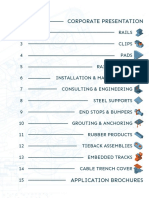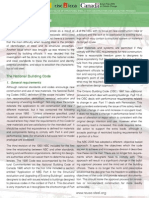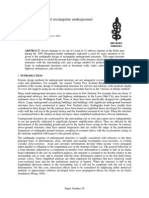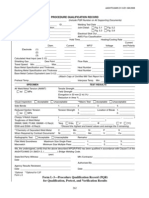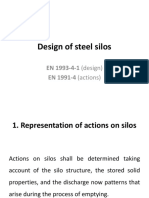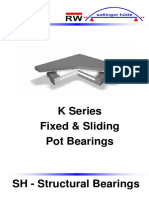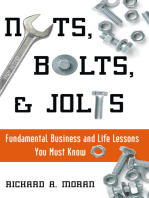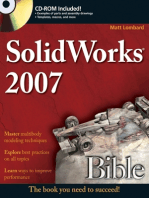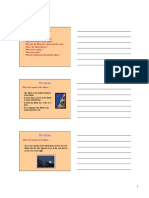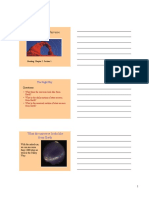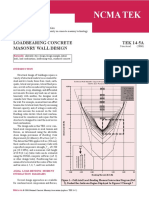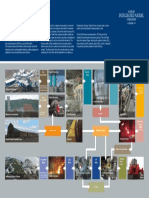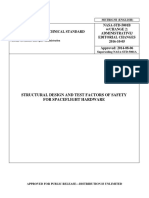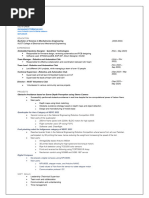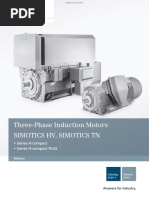A Critical Review of ASME BTH-1-2005 in The Design and Analysis of Vessel Lifting Lugs
A Critical Review of ASME BTH-1-2005 in The Design and Analysis of Vessel Lifting Lugs
Uploaded by
fostbarrCopyright:
Available Formats
A Critical Review of ASME BTH-1-2005 in The Design and Analysis of Vessel Lifting Lugs
A Critical Review of ASME BTH-1-2005 in The Design and Analysis of Vessel Lifting Lugs
Uploaded by
fostbarrOriginal Title
Copyright
Available Formats
Share this document
Did you find this document useful?
Is this content inappropriate?
Copyright:
Available Formats
A Critical Review of ASME BTH-1-2005 in The Design and Analysis of Vessel Lifting Lugs
A Critical Review of ASME BTH-1-2005 in The Design and Analysis of Vessel Lifting Lugs
Uploaded by
fostbarrCopyright:
Available Formats
See discussions, stats, and author profiles for this publication at: https://www.researchgate.
net/publication/267610545
A Critical Review of ASME BTH-1-2005 in the Design and Analysis of Vessel
Lifting Lugs
Conference Paper · January 2007
DOI: 10.1115/PVP2007-26071
CITATIONS READS
0 3,140
1 author:
Dennis Keith Williams
DR. DENNIS K. WILLIAMS, P.E.
44 PUBLICATIONS 105 CITATIONS
SEE PROFILE
Some of the authors of this publication are also working on these related projects:
Piping Supports & Restraints View project
All content following this page was uploaded by Dennis Keith Williams on 08 December 2015.
The user has requested enhancement of the downloaded file.
Proceedings of PVP2007
2007 ASME Pressure Vessels and Piping Division Conference
July 22-26,Proceedings of PVP2007
2007, San Antonio, Texas
2007 ASME Pressure Vessels and Piping Division Conference
July 22-26, 2007, San Antonio, Texas
PVP2007-26071
PVP2007-26071
A Critical Review of ASME BTH-1-2005 in the Design & Analysis of Vessel Lifting Lugs
Dennis K. Williams
Sharoden Engineering Consultants, P.A.
P.O. Box 1336
Matthews, NC 28106-1336
Tel: 704-591-3995
Email: DennisKW@sharoden.com
ABSTRACT analysis of vessel lifting lugs in consideration of current
This paper presents a critical review of the newly regulations.
published ASME BTH-1-2005, which is intended to be a Keywords: lifting lugs, OSHA, below-the-hook
companion to ASME B30.20, Below the Hook Lifting Devices, INTRODUCTION
a safety standard. The very limited structural design criteria The basic approach of the current study is to first define
contained in the latter standard was previously addressed in the the mode of failure against which any design criterion and/or
literature by the current author and was compared against the standard must try to protect during the design phase of a vessel
various national and international regulations, codes, and lifting lug. Second, the approach selects a failure criterion
standards in regard to the presumed factors of safety inherent in from those commonly discussed in the literature, such as
the designs of vessel lifting lugs. Based upon the criteria maximum shear stress theory, maximum octahedral shear stress
previously outlined and addressed, the current American theory, and maximum principal stress theory, that most closely
National Standard ASME BTH-1-2005 is critically reviewed matches the mode of failure defined in the first step of the basic
and the commentary that is now incorporated in such is approach. Third, the method adopts an “achievable” factor of
analyzed in an effort to determine the adequacy of the updates safety based upon the chosen failure theory from step two of
in meeting and exceeding the current regulations in both the the approach and applies the FOS against the respective
United States and Canada. The statutory and provincial “failure” stress. Finally, a well-defined design criterion for
regulations in both the United States and the province of vessel lifting lugs is outlined based upon the basic approach
Alberta, Canada are also reviewed and discussed with respect presented herein and applied to the statutory and provincial
to the too often utilized phrase “factor of safety” (FOS). The regulations contained within 29CFR1926 (OSHA regulations)
implied implications derived from the chosen FOS are also [1] and the Occupational Health and Safety Act of the Province
outlined. of Alberta, Canada, which precipitated both the Occupational
Exemplar lugs on vessels are defined and the finite Health and Safety (OHS) Regulation [2] and the OHS Code
element analyses and closed form Hertzian contact problem [3].
solutions are presented and interpreted in accordance with the The purpose of this paper is to provide technical insight
new ASME BTH-1-2005 structural design criteria. These into the applied mechanics evaluation of an exemplar pressure
results are again highlighted against the very limited design vessel lifting lug, present a critical review of the newly
information contained within ASME B30.20. A review of the published ASME BTH-1-2005 [4], which is intended to be a
author’s prior recommendations made to revise the ASME companion to the standard ASME B30.20, Below the Hook
B30.20 Below the Hook Lifting Devices safety standard are Lifting Devices [5], and reflect on the design criteria for vessel
presented and discussed in light of the examples and technical lifting lugs previously proposed by Williams [6]. The subject
justification presented in the following paragraphs. Contact lifting lug is one whose design load capacity is 700 metric tons
stresses that are well known to exist between a lifting pin and (approximately 1,544,000 lbf). This load capacity is not
clevis type geometry are also discussed in light of the new uncommon in the petroleum refinery industry for a number of
structural design criteria contained within ASME BTH-1-2005. specialty types of ASME B&PV Code, Section VIII [7]
Additional recommendations are provided for the design and hydrotreater vessels. On many project designs, there are at
least two types of imposed design bases for the lifting and
1 Copyright © 2007 by ASME
handling equipment. The first of these design bases is an lifting bolt/pin was performed utilizing the techniques
internally generated or self-imposed design basis. The second presented by Timoshenko and Goodier [8] and summarized for
of these design bases is one that may be classified as an direct application by Young [9]. The lug geometry itself is a
externally generated design basis. For purposes of this simple clevis type design of uniform thickness as shown in
discussion, “internal” and “external” refer to an organization Figure 1. The second analysis utilized the finite element
within the design engineering organization (hence internal) or method to quantify the effects of the contact stresses within the
to an outside authority having jurisdiction (hence external) [6]. lug and also utilized the calculated results to serve as a basis for
The internal design basis for the lifting lug can further be the proposed lug design criteria. In this manner, the proposed
defined by either internally generated design and analysis lug design criteria achieved two goals. The first ensured a safe
criteria or by externally generated codes and safety standards. and practical design. The second provided a design that was in
The internally generated criteria most often attempt to define an full compliance with the regulatory requirements identified in
“allowable” set of component stresses that restrict the reference [6]. A similar comparison is made in the following
computed bending, bearing, and shear stresses within the lifting paragraphs with the current regulatory requirements defined in
lug critical sections as determined by both experience and references [1], [2], and [3].
empirical data. While there are no uniform set of criteria
amongst the numerous engineering design professionals ASME B30.20: BELOW THE HOOK LIFTING DEVICES
throughout the United States and Canada, one guideline that is According to the foreword provided within ASME B30.20
often promoted, is the limitation of the bending stress to one [5], the Standard presents a coordinated set of rules that may
third of the yield strength of the lug material. The additional serve as a guide to government and other regulatory bodies
component stresses and the associated allowable stresses vary responsible for the “guarding and inspection” of the equipment
widely across-the-board, depending on the particular design falling within its scope. Furthermore, the Foreword to the
engineering group and experience. The externally generated or referenced ASME Standard [5] urges administrative and
imposed “design” standard on lifting lugs often falls on the regulatory agencies to “consult the B30 Committee” prior to
limited criteria contained within the ASME safety standard rendering decisions on disputed points. The Foreword
B30.20 [5] and more recently, ASME BTH-1-2005 [4]. concludes with the protective remark that, “revisions [to the
Williams [6] previously addressed and discussed in detail the Standard] do not imply that previous editions were inadequate.”
“fallback” position employed by many engineering These items have previously been considered and discussed in
organizations in attempting to utilize the “design” criteria some detail by the author [6].
contained in reference [5] and the inherent pitfalls of such a Within the Introduction to ASME B30.20 [5], the
practice, particularly when applied to lifting lugs for large Standards Committee states that they fully realize the
pressure vessels. importance of proper design factors. In addition, the Standards
The second major group of design basis criteria originates Committee states that, “[they] will be glad to receive criticisms
from an outside source and most often take the form of of this Standard’s requirements and suggestions for its
regulatory requirements defined by Federal, State, and/or improvement, especially those based on actual experience in
Provincial authorities having jurisdiction [6]. Only the application of the rules” [5]. Since the time of publication of
regulations imposed in the United States and the Province of ASME B30.20 [5], a much more detailed set of “design” rules
Alberta, Canada are discussed herein, although the subject for below-the-hook lifting devices has finally been issued by
discussion is one that has universal implications. This becomes the B30 Committee in the form of ASME BTH-1-2005 [4].
even more apparent as fabricators across the globe are This standard is reviewed and discussed in the paragraphs that
providing ASME Code [7] pressure vessels intended for follow herein.
installation in both the United States and Canada. The specific Within the scope of ASME B30.20 [5] is the
design lifting requirements imposed by the U.S. Department of “construction” of lifting devices. Some engineers interpret the
Labor, 29CFR1926 (OSHA regulations) [1] are outlined and 700 metric ton lifting lug under consideration to fall within the
the implementation of a 5 to 1 “factor of safety” is also scope of the subject Standard [5]. While Chapter 20-1 entitled
explored. Finally, the Provincial Regulations contained within “Structural and Mechanical Lifting Devices” [5] does not
the Occupational Health and Safety Act of the Province of specifically categorize the lifting lug under consideration, many
Alberta, Canada, with the associated OHS Regulation [2] and design organizations cite this chapter for use as a design
the OHS Code [3] are also reviewed and discussed with further guideline or requirement. In particular, paragraph 20-1.1.1
interpretation of a very specific 5 to 1 factor of safety on the entitled “General Construction”, outlines the “design”
ultimate “breaking” strength of the chosen lug material. requirements for a lifter as follows:
The analysis of the 700 metric ton lifting lug was
conducted in two separate manners as described by Williams “The load bearing structural components of a lifter shall
[6]. First, the analysis and prediction of the contact stresses, be designed to withstand stresses imposed by its rated load plus
the general stress field within the critical sections of the lug, the weight of the lifter, with a minimum design factor of three,
and the associated contact area between a close tolerance fitting based upon yield strength of the material, and with stress
2 Copyright © 2007 by ASME
ranges that do not exceed the values given in ANSI/AWS D14.1 conjunction with ASME B30.20 [5], which addresses primarily
[10] for the applicable conditions” [5]. safety requirements. ASME BTH-1 does not replace ASME
B30.20. The design criteria set forth in reference [4] are
The author previously noted six observations on the minimum requirements that may be increased at the discretion
existing ASME Standard [5] that needed to be addressed in of the lifting device manufacturer or a qualified person.
some detail. These observations are repeated herein for While the B30 Committee states that, “Although always
establishing the basis for review of the complementary implied, this provision [ASME BTH-1-2005] now explicitly
standard, ASME BTH-1-2005 [4], which should have either states that the design of below-the-hook lifting devices is the
provided further design guidance, requirements, or responsibility of a qualified person,” this statement alone adds
clarifications to the inadequacies of ASME B30.20 [5] as a little (if anything) to the establishment of current safe practices
stand-alone document. First, the placement of a “design in the design and analysis of below the hook lifting devices.
requirement” under the heading of “Construction” was not This requirement has been established in recognition of the
consistent with the organization of many other ASME Codes impact that the performance of a lifting device has on
and Standards [7] in that design criteria are clearly labeled as workplace safety, the complexity of the design process, and the
such and are also segregated from the construction (i.e., level of knowledge and training required to competently design
fabrication) requirements. Second, the design requirement lifting devices [4].
contained within the referenced Standard [5] only gave the The original ASME B30.20 structural design requirements
engineer a very vague idea as to which particular computed defined a lifting device only in terms of its rated load [4]. Later
stresses must be compared against the material yield stress editions established fatigue life requirements by reference to
divided by three. Third, the choice of an “allowable” stress of ANSI/AWS D14.1. ASME BTH-1 now defines the design
sorts by the Standard [5] that is based upon yield implied a requirements of a lifter in terms of the rated load, the Design
“failure criterion” that would preclude the initiation of yielding Category, and the Service Class to better match the design of
within the lug material when subjected to its maximum rated the lifter to its intended service [4]. The bases of the Design
load. Fourth, the selection of a yield based failure criterion Categories and Service Classes can be found in Chapters 2 and
implied that the anticipated failure mode would be one of a 3 Commentaries of the design Standard [4]. The inclusion of
ductile nature (of course assuming the selection of a linear, commentaries within the Standard [4] follows the pattern of
elastic, homogeneous, and isotropic lug material). Fifth, the several other ASCE standards that address the complexities
utilization of a large capacity vessel lifting lug will typically associated with various applied mechanics applications.
only be subjected to a very limited number of “lift cycles”, as
once the vessel is moved from the fabricator’s shop and up- ASME BTH-1-2005 CRITICAL ASSESSMENT
righted in the field, it generally is there for the remainder of its The allowable stresses defined in Chapters 3 and 4 have
intended design life. Sixth, the subject design problem clearly been developed based on the presumption that the actual
involves contact stresses between a shackle pin and a clevis stresses due to the design loads will be computed using
hole, which implies very large contact stresses that are highly classical methods [4]. The Standard [4] opines that such
localized. Whether the complementary standard adequately methods effectively compute average stresses acting on a
addresses these contact stresses is reviewed and discussed in structural or mechanical element. The Standard [4] further
the paragraphs that follow. Furthermore, it is these six opines that consideration of the effects of stress concentrations
observations in combination with other regulatory requirements is not normally required when determining the static strength of
that are explored in some detail in the paragraphs that follow. a structural component (see Commentary for paragraph 3-5.2
[4]); however, the effects of stress concentrations are most
ASME BTH-1-2005 BACKGROUND & FOREWORD important when determining fatigue life. Lifting devices often
ASME BTH-1-2005 [4] was developed in response to the are constructed with discontinuities or geometric stress
need to provide clarification of the intent of ASME B30.20 concentrations, such as pin and bolt holes, notches, inside
with respect to the structural design of below-the-hook lifting corners, and shaft keyways that act as initiation sites for fatigue
devices. Since the original publication of ASME B30.20 in cracks. The design Standard then erroneously states and opines
1986, users have requested interpretations of the construction that analysis of a lifting device with discontinuities using linear
requirements stated therein, as the safety standard was almost finite element analysis will typically show peak stresses that
silent on structural design guidance and requirements. indicate failure, where failure is defined as the point at which
According to the Standard [4], the level of detail required to the applied load reaches the loss of function load (or limit state)
provide adequate answers to the questions submitted extended of the part or device under consideration. The design Standard
beyond that which could be covered by interpretations of a B30 [4] further states that, “This is particularly true when evaluating
safety standard as previously implied in the previous work by static strength.” While the use of such methods is not
Williams [6]. prohibited, modeling of the device and interpretation of the
ASME BTH-1-2005 [4] addresses only design results demands suitable expertise to assure the requirements of
requirements. As such, this Standard should be used in this standard are met without creating unnecessarily
3 Copyright © 2007 by ASME
conservative limits for static strength and fatigue life [4]. recognition that “some lifter applications may result in greater
These statements and inherent attitudes of the B30 Committee dynamic loading that will necessitate higher design factors”
imply a gross distrust of the capabilities of the finite element and that “it is the responsibility of a qualified person to
method as a design tool and that the method actually can determine when higher design factors are required and to
“indicate failure.” There is nothing more further from the truth determine the appropriate values in such cases.” In fact, the
in that the ultimate determination of “failure” lies with the basic previous recognition on the part of the authors of the Standard
definition of “failure” as defined the analyst and not with the [4] is a clear statement that the applicability of the structural
tool that may be utilized to calculate stresses and design requirements are limited and not all encompassing to all
displacements! In this respect, the finite element method is no lifting device components, including, but not limited to, vessel
different than the engineer who may still use a slide rule or lifting lugs.
calculator to arrive at value for a principal stress, a buckling In the author’s opinion, one of the most objectionable
load, or a maximum radial displacement. statements included in the Standard [4] is that contained in the
Chapter 3, entitled “Structural Design” [4] states that the Commentary to paragraph 3-1.6, Allowable Stresses, which
member allowable stresses have “generally been derived based states:
on the assumption of the members being prismatic.” In
reviewing the universally accepted failure theories such as “The allowable stresses and stress ranges defined in
those based upon the maximum shear stress (i.e., Tresca) and paras. 3-2, 3-3, and 3-4 are to be compared to average or
the maximum octahedral stress (i.e., von Mises) [11], there nominal calculated stresses due to the loads defined in para. 3-
appears to be no mention of limitations for the use of either 1.2. It is not intended that highly localized peak stresses that
criterion upon non-prismatic members. Quite simply, geometry may be determined by computer aided methods of analysis, and
of a member cross section does not preclude the use of the which may be blunted by confined yielding, must be less than
criteria when trying to establish a prediction of either the onset the specified allowable stresses.”
of yielding or the establishment of a new yield surface in an
elastic-plastic analysis. Such assumptions in the Standard’s [4] First, whether the stress analysis of a lifting device is
commentary appear to be without technical merit and should be conducted by “computer aided methods” such as the finite
eliminated from the text. element method or through the use of closed form solutions,
The Standard [4] explains that an added “impact factor” such as those associated with simple bending and shear stress
over and above the design factors of 2.00 and 3.00 for Design evaluations, a definition need be provided by the Standard to
Category A and B lifters, respectively, is not required to be “classify” which, if any stresses are “peak stresses”.
applied to the “actual applied loads.” Interestingly enough, the Historically, the ASME nuclear based Codes [7,12] have been
Standard specifically points out that AISC reported in 1974 that the only ones that utilized a true stress classification hopper
typical dynamic loads were on the order of 20% of the lifted with specifically defined allowable stresses for membrane,
load, while the upper bound dynamic load was about 50% of membrane-plus-bending, and membrane-plus-bending-plus
the same. While these results may be a starting basis for peak stresses. Furthermore, these ASME Codes recognized the
consideration of the necessity for impact factors, the standard is difference between primary and secondary stresses and the
silent on the issue of lifting device catastrophic failures in the effects of the same on the respective type of failure. The
field and the lifted load at the time of failure. Simply stated, it subject Standard [4] fails to provide this type of stress
is the failed lifting devices that the Standard should seek to classification.
base the ultimate margin of safety and impact factors upon, not Second, the Standard [4] fails to recognize the importance
those that did not fail during lifts. It is most easy to measure an of the mature finite element methods in the determination of the
actual lifted load, but the service failure load under varying detailed displacement and stress fields in lifting devices. While
conditions is what the margins of safety and impact load factors the Standard is again silent on this matter and neither provides
must be based. guidance either directly or indirectly through reference to other
The Standard [4] implies that a design factor of 3.00 has ASME or Welding Research Council codes and bulletins, stress
“traditionally been” utilized to safeguard against yielding since classification methods have been utilized for many years in the
the inception of ASME B30.20. Based upon previous pressure vessel industry. Furthermore, during the last decade,
publications by the author [6], very limited design information the Pressure Vessel Research Council sponsored some of the
was ever contained in ASME B30.20 [5] and certainly the leading experts in the area of stress classification techniques as
design of clevis type lifting lugs could never be assured of applied to the ASME Boiler and Pressure Code to author the
limiting the state of stress below the minimum specified yield guidelines that were published in WRC Bulletin 429 [13].
point of the lug material, unless of course the lug was never These guidelines should have been included by reference, as a
utilized in a lift! The Standard does recognize, however, that minimum, in the subject ASME Standard [4], recognizing the
“in some cases, it will be necessary for [a] qualified person to widespread use of the finite element method in the design and
employ design methods not specifically addressed herein.” The analysis of structural and mechanical components by today’s
Standard [4] continues to provide some clarification with the engineers.
4 Copyright © 2007 by ASME
The temperature limits adopted in the ASME BTH-1-2005 Federal Regulations (CFR), numerous references are made to
[4] are based on the experience that the B30 Committee has slings, wire rope, hooks, shackles, and other forms of material
amassed. The Standard [4] correctly points out that historically, handling and other forms of lifting equipment [1]. In
tension brittle failures have occurred during hydrotest in particular, the regulations that are of most importance during
pressure vessels fabricated from low carbon steel at the up-righting and lifting of a pressure vessel are found in
temperatures as high as 50°F (10°C). Flaws in steel plate Title 29, Part 1926, Subpart 251 entitled “Rigging Equipment
material were the primary cause of these failures [4]. With for Material Handling” [1]. This and other OSHA Regulations
tighter production processes, closer metallurgical control, and may be easily found on the Internet at URL
better quality checks in current practice, the risk of such failure http://www.osha.gov.
is reduced [4]. Thus, the Committee selected the 25°F (−4°C) While there are numerous similarities between ASME
temperature as a reasonable lower limit. This lower B30.20 [5] and 29CFR1926.251 [1] regarding the inspection of
temperature limit is also consistent with recommendations the lifting equipment (including, but not limited to lifting lugs)
made by AISC (2003). The Committee selected the upper prior to use, there exists a striking difference in the “design”
temperature limit as a reasonable maximum temperature of criteria for the handling devices. The OSHA requirements
operation in a summer desert environment [4]. The Standard specifically define that the safe working loads of shackles and
[4], in an attempt to reference some ASME works, states that “specific identifiable products” be designed with a “safety
data from the ASME Boiler & Pressure Vessel Code material factor of not less than 5”, although the safety factor is not
design tables “indicate that some carbon steels have already explicitly defined therein [1]. The FOS of 5 is repeatedly
begun to decline in both yield stress and allowable tension echoed throughout this and other OSHA Regulations regarding
stress at 200°F (93°C).” This statement is almost sophomoric handling equipment.
from the standpoint that “allowable stresses” as presented in As in the proceeding section, there are several observations
Section II, Part D of the ASME Boiler and Pressure Vessel that must be discussed concerning the preceding design
Code [14] are most often based on some percentage of either requirement. First, the OSHA design requirement [1] gives the
the minimum specified yield strength or the ultimate tensile engineer no suggestion or proposal as to which particular
strength. Obviously, these material characteristics never computed stresses must be compared against essentially the
increase with increasing temperature, so therefore the allowable material’s ultimate tensile stress divided by five. This assumes
stresses must also decrease with increasing temperature! Some that the failure load, however, is proportional to the ultimate
materials decline by as much as 4.6%, but most are less than tensile failure stress (or vice-versa) in the application of the
that amount. A straight-line interpolation between the tabulated FOS as recommended by Boresi et al [11]. Second, the choice
values for materials at 100°F (38°C) and 200°F (93°C) in this of an “allowable” stress of sorts by the Regulation [1], which is
reference gives acceptable stress values that have minimal based upon what is assumed to be a FOS of 5 applied to the
degradation at 150°F (66°C). In some industrial uses, lifting ultimate tensile strength, implies some sort of “failure criteria”
devices can be subjected to temperatures in excess of 1,000°F that would be based on a predominant component stress or
(540°C). At these temperatures, the mechanical properties of computed maximum principal stress when subjected to its
most materials are greatly reduced over those at ambient. If the maximum rated load. Third, the selection of an ultimate tensile
exposure is prolonged and cyclic in nature, the creep rupture strength based failure criteria would most likely also imply that
strength of the material, which is lower than the simple the anticipated failure mode would be one of a brittle nature
elevated temperature value, must be used in determining the (even though the lug material is most assuredly classified as a
design rated load and life of the device. Of importance when ductile material under ordinary loading conditions). Fourth,
evaluating the effects of temperature is the temperature of the similar to the discussion on ASME B30.20 [5], the utilization
lifter component rather than the ambient temperature. A lifter of a large capacity vessel lifting lug will typically only be
may move briefly through an area of frigid air without the subjected to a very limited number of “lift cycles”, for the
temperature of the steel dropping to the point of concern. reasons previously cited. Finally, the subject design problem
Likewise, a lifter that handles very hot items may have some clearly involves contact stresses between a shackle pin and a
components that become heated due to contact. In an effort to clevis hole, which obviously implies the existence of very large
define these lifting devices metal temperatures, a competent contact stresses that are highly localized. It is these very
heat transfer analysis would have to be performed and contact stresses that are still not addressed by ASME BTH-1-
interpreted in accordance with the design Standard [4]. 2005 [4], ASME B30.20 [5], or any other regulation known to
this author.
OSHA RIGGING EQUIPMENT REGULATIONS IN THE
UNITED STATES ALBERTA OCCUPATIONAL HEALTH & SAFETY ACT
The U.S. Department of Labor, through the regulations The Province of Alberta, Canada, through the regulations
specified by its Occupational Health and Safety Administration specified by its Occupational Health and Safety Act, Regulation
(OSHA), specifies the general safety requirements for rigging 62/2003 [2], addresses the general safety requirements related
equipment for material handling. Throughout the U.S. Code of to government policy and administrative matters for rigging
5 Copyright © 2007 by ASME
equipment for material handling. The Occupational Health and in the application of the 5-to-1 FOS. Second, the choice of an
Safety Code [3] specifies all of the mandatory technical “allowable” stress of sorts by the OSHA Regulation [1] that is
standards and safety rules with which employers and workers based upon what is assumed to be a FOS of 5 applied to the
must comply. The Code took effect on April 30, 2004 and ultimate tensile strength implies some sort of “failure criteria”
replaced eleven individual occupational health and safety that would be based on a predominant component stress or
regulations, including AR 448/83 [15] which was previously computed maximum principal stress when subjected to its
discussed in detail by Williams [6]. Similar to the OSHA maximum rated load. Third, the selection of an ultimate tensile
Regulation [1] previously discussed, within the Alberta Code strength based failure criteria would most likely also imply that
[3], numerous references are made to slings, wire rope, hooks, the anticipated failure mode would be one of a brittle nature.
shackles, and other forms of material handling and other forms Fourth, similar to the discussion on ASME B30.20, the
of lifting equipment. In particular, the regulations that are of utilization of a large capacity vessel lifting lug will typically be
most importance during the up-righting and lifting of a pressure subjected to only a very limited number of “lift cycles”, for the
vessel are found in Part 21, entitled, “Rigging”, paragraph reasons previously cited. Finally, as with all the other
292(1) [3]. This and other Alberta Regulations may be found regulations and standards previously cited, the very large
on the Internet at URL http://www.gov.ab.ca contact stresses, which are highly localized, are not addressed
Once again, there are numerous similarities between by this Provincial Code [3] as well.
ASME B30.20 [5], 29CFR1926.251 [1], and Alberta OHS
Code 62/2003 [3] regarding the inspection of the lifting CLASSICAL CONTACT STRESS EVALUATIONS
equipment (including, but not limited to lifting lugs) prior to The problem presented by the design of a vessel lifting lug
use. The Alberta Code, however, begins to define the “design” is first and foremost one created by the Hertzian contact of a
criteria of the handling devices more specifically than the lifting pin (supported by a shackle in this case) with that of the
OSHA regulations and takes on a different basis for the FOS lifting hole in a clevis-type lifting lug. The resulting stresses of
than even ASME B30.20 [5]. The Code [3] requirements the greatest magnitude are indeed those created by the pressure
specifically state that the maximum safe working load of exerted by the pin on the clevis over a limited area of contact.
rigging or rigging equipment must not “exceed … 20% of the The Hertzian contact stress problem is treated and discussed in
ultimate breaking strength of the weakest component of the detail in Chapter 14 the text by Boresi [11], by Timoshenko [8],
rigging” if a worker is not being raised or lowered. As with the and by Young [9]. It is these contact stresses that are not,
OSHA regulations, a FOS of 5 appears and is repeatedly however, addressed in any of the Standards or Regulations
echoed throughout this Alberta Code [3] regarding handling previously discussed in the preceding paragraphs of this paper
equipment. [1,2,3,4,5]. The only plausible justification for the silence by
The pertinent observations that must be discussed these Standards and Regulations on the obvious existence of
concerning the preceding design requirement are as follows. the contact stresses may be as explained in the following by
The design requirement [3] gives the engineer the latitude to Boresi [11]:
formulate a failure criteria based upon the “ultimate breaking
strength”, which suggests at least an ultimate tensile strength “Most load resisting members are designed on the basis of
divided by 5 as an allowable stress. This assumes that the stress in the main body of the member, that is, in portions of the
failure load is proportional to the ultimate tensile failure stress body not affected by the localized stresses at or near a surface
of contact between bodies. In other words, most failures
(excessive elastic deflection, yielding, and fracture) of members
are associated with stresses and strains in portions of the body
far removed from the points of application of the loads.” [11]
Williams [6] previously included a sample calculation for
the 700 metric ton lifting lug contact stress evaluation. The
chosen material for the lifting lug is ASME 508 Grade 3 Class
2 with an ultimate tensile strength of 90,000 psi and yield
strength of 65,000 psi. The lifting lughole diameter is 8.543 in.
within which a pin diameter of 8.460 in. must be inserted. The
thickness of the lifting lug is 11.50 in. The other dimensional
data is shown in Figure 1.
The contact stresses previously cited [6] are not applicable
close to the edges where the contact boundary begins. This
sharp interface area can produce highly localized stresses in
excess of 100,000 psi [11] for the 700 metric ton loading under
FIGURE 1 – LIFTING LUG GEOMETRY consideration. The depths at which the effects of the contact
6 Copyright © 2007 by ASME
stresses are significant range from the surface of contact (for material behavior in which relatively large shearing stresses are
the maximum principal stress) to an approximate depth of 1.6 developed [11]. For the problem at hand, Williams [6]
in. (for the maximum shear stress and the maximum octahedral previously identified that the maximum shearing stress would
shearing stress). Nevertheless, the results of the contact stress be limited to no more than 32,500 psi prior to the application of
reveal at least two important pieces of information. The first is any FOS!
that the average contact stress for the loading, geometry, and The maximum octahedral shear stress failure theory states
materials of construction defined herein are approximately that inelastic action in any point in a part initiates when the
40,000 psi. Keeping in mind that this is a compressive stress computed octahedral shearing stress reaches 0.471 times the
and that when compared to a yield strength of at least 65,000 material’s yield strength. In many ductile materials utilized
psi, this is far below those levels of bearing and/or compressive within the pressure vessel industry, the octahedral shearing
stress allowed within other ASME Codes [7,12]. The second stress criterion predicts the initiation of yield better and with
important piece of information is the calculated width of the less conservatism than does the Tresca criterion. For the
assumed rectangle contact area. For the subject design, this problem at hand, Williams [6] previously identified that the
width is calculated to be approximately 4.35 in., which equates maximum octahedral shearing stress would be limited to no
to a half angle from top dead center of approximately 30° for more than 30,641 psi prior to the application of any FOS!
the contact area [6]. This value is and can be utilized in a more The maximum principal failure theory is one that may be
detailed finite element analysis of the lifting lug and represents easily employed to establish the initiation of yield for a brittle
the angular dimension over which the lifting load may be material or one that may be employed to establish a guard
applied. against fracture through the use of the ultimate tensile strength
(UTS) and an imposed FOS. Even though the chosen material
CLASSICAL FAILURE THEORIES & THE ULTIMATE for a vessel lifting lug should be one of high ductility and
FACTOR OF SAFETY possess good impact properties, the failure mechanism due to a
In determining the possible modes of failure, the engineer sudden acceleration (i.e., a dynamic load) in most cases will be
must also establish the failure criteria by which the design will one of a brittle nature. Therefore, Rankine’s criterion, when
be judged. The modes of failure for the lug must include not modified to utilize the UTS, provides both an easy to use
only the common static causes such as bending, shear, and criterion and one that is consistent with the expected mode of
bearing, but also the effects of a dynamic or shock loading due failure! For the problem at hand, Williams [6] previously
to the lift itself. It is this consideration of a potential dynamic identified that the maximum principal stress would be limited
load (generated as a result of the sudden loss of tension in a to 90,000 psi divided by the chosen FOS! This also implies
cable or sling) that drives the need for a form of a FOS to be that the minimum principal stress must be addressed as a
employed to the applied static load or resulting computed separate matter. This is because the failure mode that must be
stress. Furthermore, the selection of a failure criteria for the guarded against is one, first and foremost, which would be
lifting lug must be predicated upon this dynamic load tensile in nature and tend to open any preexisting cracks in the
consideration and not the initiation of yield per se, as the lug lifting lug material.
will only be utilized a very few number of times in its design
life (i.e., certainly no more than 10 times). It is not only the CRITERIA FOR CONSIDERATION IN THE DESIGN &
specification of a single FOS but also the failure criterion that ANALYSIS OF PRESSURE VESSEL LIFTING LUGS
determines the ultimate factor of safety of a given lifting device In an effort to more fully understand the stress field within
design. the 700 metric ton lifting lug, a finite element analysis was
Boresi [11] states, “There is considerable but not performed and discussed by Williams [6]. The details of the
necessarily conclusive evidence … that when a member fails finite element analysis were also previously described by
by general yielding at ordinary temperatures, the significant Williams [6]. The base of the lug was fixed against translation
quantity associated with the failure is shearing stress.” Two of in all three coordinate directions, as the elements chosen to
the most widely utilized failure criteria that address general model the geometry were a three-dimensional solid with 3
yielding include the maximum shearing stress (Tresca’s degrees of freedom at each node (i.e., translations in the x, y,
criterion) and the maximum octahedral stress (Von Mises and z directions). The 700 metric ton load was evenly
criterion) theories. A third criterion is the maximum principal distributed within a 30° half angle from top dead center on each
stress theory of failure (Rankine’s criterion). The engineer side of the symmetry plane and continued through-the-
must remember that in a uniaxial state of stress, the critical thickness of the lifting lug. Several mesh densities were
“failure” values for each of the defined theories are achieved employed until the stress results converged to within 3% of the
simultaneously during a simple tensile test! more course mesh density [6].
Tresca’s criterion states that inelastic action in any point in The results of the finite element analysis were decomposed
a part initiates when the computed maximum shearing stress into all of the constituent component stresses. In addition, the
reaches the half of the material’s yield strength. While the results were also reviewed in light of the three failure criteria
maximum shear stress failure theory is best suited for ductile previously defined and outlined above. The stress contours
7 Copyright © 2007 by ASME
significant mode of failure (i.e., from a dynamic load), the
1 ANSYS 5.6.1
MAR 10 2002
22:00:03
maximum principal stress failure criteria should be utilized.
PLOT NO. 2
NODAL SOLUTION While attempts by the ASME B30.20 Safety Standard [5]
STEP=1
SUB =1
TIME=1
highlights the use of a one-third yield criterion, there is no
S1 (AVG)
PowerGraphics
EFACET=1
single published failure criterion known to this author that can
MX
MN
AVRES=Mat
DMX =.014536
address all of the aspects of the lug design with this method. In
SMN =-13133
SMX =53276
-13133
this author’s opinion, the simple limitation a single type of
-5754
1624 component stress (for example, a bending stress) to some
9003
16382
23761
allowable value hardly defines a “failure criterion” for use in
31139
38518 the current or future design of lifting lugs. Furthermore,
45897
53276 applying this limitation (i.e., the one-third yield criterion) on
the compressive stresses present in the contact area, simply
Y
ZX
does not work nor will it work in a tri-axial state of stress!
700 Ton Lifting Lug Analysis Second, in conjunction with the chosen criterion, the maximum
principal stresses should be calculated for the given working
FIGURE 2 – MAX. PRINCIPAL STRESS load and lug geometry. The load should be distributed over a
contact area as determined by either an acceptable contact
showing the calculated maximum principal stresses are stress technique such as that previously presented by Williams
included in Fig. 2. The interested reader is referred to the [6] or by a nonlinear finite element contact stress analysis
previous work on this subject for the remaining stress contours procedure. The resulting maximum principal stresses in the
[6]. All of the contours reflect a highly concentrated respective body of the lug that are located slightly beyond the area of load
combined stress at the geometric discontinuity between the lug application should then be compared to an allowable stress
hole bore and orthogonal outside surface. This is both value equal to 20% of the UTS of the lug material. This will be
attributed to the contact load discontinuity and the reality of the consistent with both domestic and Canadian regulations
geometric/load combination. This area is very small and is not regarding the implementation of a well defined FOS of 5 on
anticipated to reflect the overall load carrying capacity of the fracture and ultimate breaking strength. Finally, the minimum
lug, regardless of the failure criterion employed. principal stresses should be computed and compared to simply
The calculated maximum principal stress as shown in one times the specified minimum yield strength of the lug
Figure 2 is approximately 53,276 psi. When compared to the material. This allowable is consistent with those specified in
equivalent allowable stress of 1.0 times yield (i.e., 65,000 psi), other ASME Codes [7,12] and the compressive stresses do not
this represents a margin of approximately 18% without pose the same crack opening hazard found in purely tensile
employing any factor of safety. As the distance from the stresses. Utilizing this method of analysis not only achieves a
applied contact load increases, the stress contour reveals that an clear utilization of a highly recognized FOS, but also addresses
overall maximum principal stress throughout the body of the the issue of contact stresses about which the Regulations and
lifting lug quickly decreases to a value of approximately 16,400 Standards identified herein have remained forever silent.
psi. In order to fully evaluate the FOS for this criterion, these
values may be compared to the one times yield, which results in SUMMARY & CONCLUSIONS
a FOS of approximately 3.96 on the initiation of yield. As A method for evaluating the structural adequacy of various
stated previously however, this is not a good predictor of yield lifting lugs utilized in the erection and up-righting of large
and is most well suited for use with the ultimate tensile strength pressure vessels was confirmed and reiterated from a previous
in this case. Proceeding on this basis, these values must be publication of the same topic. The analysis techniques were
compared to the UTS, which results in a FOS of approximately described and design guidelines for vessel lifting lugs were
5.49 on the ultimate failure load (assuming totally elastic tendered. The statutory and provincial regulations in both the
response, which is a conservative predictor). In contrast, the United States and the province of Alberta, Canada were also
calculated minimum principal stress was found to be reviewed and discussed with respect to the too often utilized
approximately –61,292 psi [6], which is reflective of the phrase “factor of safety” (FOS). Hopefully, the introduction of
compressive contact stress between the lifting pin and lug hole. a clearly defined FOS of 5, when utilized with the maximum
Again it is recognized that the subject lifting lug design would principal stress failure criterion, will serve as a constructive
have a much higher load carrying capacity than that predicted criticism to the design criteria given in the current ASME
by this criterion due to the reasons previously stated. Safety Standard B30.20 [5] and the sister standard ASME
Based upon the results of the detailed finite element BTH-1-2005 [4] and may be applied to lifting lugs for large
analysis of the 700 metric ton lifting lug, the following design and heavy-weight pressure vessels in future design standards.
criteria are tendered for consideration, in spite of the more Due to the limited number of repetitive loading cycles that
detailed guidelines presented in ASME BTH-1-2005 [4]. First, vessel lifting lugs actually experience during the service life of
in an effort to align the chosen failure criterion with the most a vessel, a recommendation is made to either clearly exclude
8 Copyright © 2007 by ASME
vessel lifting lugs from the scope of ASME B30.20 [5]. The [10] AWS, 1997, Specification for Welding Industrial and Mill
creation of a separate standard [4] was published by ASME Cranes & Other Material Handling Equipment,
subsequent to the original work in 2002 that inspired reference ANSI/AWS D14.1-1997, American Welding Society,
[6] in an effort to define detailed design standards for lifting Miami, FL.
devices. Based on the results presented herein, it is hoped that [11] Boresi, A. P., Sidebottom, O. M., Seely, F. B., and Smith,
a more rigorous assessment of the failure modes and the proper J. O., 1978, Advanced Mechanics of Materials, Third
selection of a failure criterion will be further studied and Edition, John Wiley & Sons, New York, NY.
revised as necessary by the ASME B30.20 Committee, thereby [12] ASME, 2004, ASME Boiler & Pressure Vessel Code,
leaving less to chance for the less experienced design engineer Section III, Subsection NB, Class 1 Components,
of rigging and materials handling equipment. American Society of Mechanical Engineers, New York.
[13] Welding Research Council, 1998, 3D Stress Criteria-
METRIC EQUIVALENTS Guidelines for Application, February 1998, Welding
The units utilized throughout this paper employed English Research Council, New York.
units in all descriptions. In order to aid readers who may be [14] ASME, 2004, ASME Boiler & Pressure Vessel Code,
more familiar with metric units, the following conversions may Materials, Part D, American Society of Mechanical
be applied to aid in understanding the results presented herein: Engineers, New York.
[15] Province of Alberta, Canada, 2000, Alberta Regulation
1 psi = 1 lbf/in2 = 6.8948*103 N/m2 448/83, Occupational Health & Safety Act, Queen’s
Printer for Alberta, Edmonton, Alberta, Canada.
1 inch = 2.5400*10-2 m
1 lbf = 4.4480 N
REFERENCES
[1] U.S. Department of Labor, Occupational Safety & Health
Administration, 2006, Code of Federal Regulations, Title
29, Part 1926, Safety & Health Regulations for
Construction, Subpart 251, US Government Printing
Office, Washington, D.C.
[2] Province of Alberta, Canada, 2003, Alberta Regulation
62/2003, Occupational Health & Safety Regulation,
Queen’s Printer for Alberta, Edmonton, Alberta, Canada.
[3] Province of Alberta, Canada, 2006, Occupational Health
& Safety Code, Queen’s Printer for Alberta, Edmonton,
Alberta, Canada.
[4] ASME, 2006, Design of Below-the-Hook Lifting Devices,
ASME BTH-1-2005, American Society of Mechanical
Engineers, New York.
[5] ASME, 1999, Below-the-Hook Lifting Devices, ASME
B30.20-1999, American Society of Mechanical Engineers,
New York.
[6] Williams, D. K., 2007, “A Proposed Design Criterion for
Vessel Lifting Lugs in Lieu of ASME B30.20,” ASME
Journal of Pressure Vessel Technology, May 2007,
American Society of Mechanical Engineers, New York.
[7] ASME, 2004, ASME Boiler & Pressure Vessel Code,
Rules for Construction of Pressure Vessels, Section VIII,
Division 2 – Alternate Rules, American Society of
Mechanical Engineers, New York.
[8] Timoshenko, S. P. and Goodier, J. N., 1970, Theory of
Elasticity, Third Edition, McGraw Hill Book Company,
New York.
[9] Young, W. C., 1989, Roark’s Formulas for Stress &
Strain, Sixth Edition, McGraw Hill Book Company, New
York.
9 Copyright © 2007 by ASME
View publication stats
You might also like
- 1915 Kalake BridgeDocument103 pages1915 Kalake BridgeKhanh Tran QuocNo ratings yet
- Gantrex NA Catalog March 2019Document240 pagesGantrex NA Catalog March 2019fostbarr100% (1)
- Recommendations For Shear Lag Factors For Longitudinally Welded Tension MembersDocument22 pagesRecommendations For Shear Lag Factors For Longitudinally Welded Tension MembersSergioAlcantaraNo ratings yet
- Aise 6-1Document59 pagesAise 6-1fostbarr100% (1)
- Installation QualificationDocument14 pagesInstallation QualificationTuan Nguyen100% (2)
- SFD Csa S16 09 PDFDocument116 pagesSFD Csa S16 09 PDFMohamed Abo-ZaidNo ratings yet
- 2 Concept of Limit State DesignDocument3 pages2 Concept of Limit State DesignVinoth KumarNo ratings yet
- VSL Construction SystemsDocument43 pagesVSL Construction Systemsbhawk0No ratings yet
- NZ ReidBar™ Design Guide 2016Document36 pagesNZ ReidBar™ Design Guide 2016jcvalenciaNo ratings yet
- AS 1252-83-For DimensionsDocument36 pagesAS 1252-83-For DimensionsBharatNo ratings yet
- 239-Article Text-665-1-10-20190607Document10 pages239-Article Text-665-1-10-20190607saulolmNo ratings yet
- Concrete Capacity Design of Cazaly Hangers in Shallow MembersDocument26 pagesConcrete Capacity Design of Cazaly Hangers in Shallow MembersOliver LopezNo ratings yet
- Standard Canada Lab ReportsDocument10 pagesStandard Canada Lab ReportsManiNo ratings yet
- International Codes For Unbonded Post-Tensioned Precast Concrete StructuresDocument13 pagesInternational Codes For Unbonded Post-Tensioned Precast Concrete StructurespriyanaNo ratings yet
- Hilti Malaysia - HIT Injection SystemDocument62 pagesHilti Malaysia - HIT Injection Systemgks6043No ratings yet
- Canadian Steel Codes IP 10-5Document18 pagesCanadian Steel Codes IP 10-5jackapisitNo ratings yet
- Earthquake Design of Rectangular UndergroundDocument8 pagesEarthquake Design of Rectangular UndergroundtrabajosicNo ratings yet
- Lateral Buckling Resistance of Inelastici-Beams Under Off-Shear Center LoadingDocument6 pagesLateral Buckling Resistance of Inelastici-Beams Under Off-Shear Center Loadingyacino30No ratings yet
- Harmer Drainage Price ListDocument144 pagesHarmer Drainage Price ListZuberYousufNo ratings yet
- AS3600-2018 Shear Comparison (20190107) - With MathcadDocument2 pagesAS3600-2018 Shear Comparison (20190107) - With Mathcadshashank sharmaNo ratings yet
- Precise Finite-Element Model For Pulleys Based On The Hamiltonian Form of ElasticityDocument13 pagesPrecise Finite-Element Model For Pulleys Based On The Hamiltonian Form of ElasticityShamik ChowdhuryNo ratings yet
- L3 PQRforQualificationDocument1 pageL3 PQRforQualificationBernardo LeorNo ratings yet
- All Page PDFDocument24 pagesAll Page PDFsskamalakannanNo ratings yet
- Con 1303Document8 pagesCon 1303chef100% (1)
- Mechanics of Solids: ColumnsDocument23 pagesMechanics of Solids: ColumnsZabid UllahNo ratings yet
- UK National Annex To Eurocode 3: Design of Steel StructuresDocument8 pagesUK National Annex To Eurocode 3: Design of Steel StructuresBF IchiGoNo ratings yet
- Historical Structural Steelwork HandbookDocument76 pagesHistorical Structural Steelwork Handbooksonychu999No ratings yet
- Using Design Software To Control Anchor Design - 2013 PDFDocument4 pagesUsing Design Software To Control Anchor Design - 2013 PDFbatteekhNo ratings yet
- Code of Practice RC 50002 Registration of Crushed Rock Mix Designs July 2017 PDFDocument9 pagesCode of Practice RC 50002 Registration of Crushed Rock Mix Designs July 2017 PDFKai FrankNo ratings yet
- Traffic Rail T80HT (00000002)Document3 pagesTraffic Rail T80HT (00000002)BobNobbitsNo ratings yet
- 15mm Strand Properties - VSLDocument1 page15mm Strand Properties - VSLenggmohanNo ratings yet
- Design of Crane Runway Beams With Channel Cap PDFDocument9 pagesDesign of Crane Runway Beams With Channel Cap PDFNguyen Duc CuongNo ratings yet
- Seismic Design of Multi-Tiered Steel Braced Frames Including The Contribution From Gravity ColumnsDocument21 pagesSeismic Design of Multi-Tiered Steel Braced Frames Including The Contribution From Gravity ColumnsDiego Matias Burgos FuentesNo ratings yet
- CEMA TR2015 01 RiskDocument18 pagesCEMA TR2015 01 RiskJean Paul Prieto GarcíaNo ratings yet
- Load and Resistance Factor Design LFRDDocument10 pagesLoad and Resistance Factor Design LFRDsalmanNo ratings yet
- Bearing Design - Steel ReinforcementDocument10 pagesBearing Design - Steel ReinforcementRajesh Sarswa100% (1)
- Analysis and Design of Semi-Rigid Steel FramesDocument13 pagesAnalysis and Design of Semi-Rigid Steel Framesbackn47No ratings yet
- Elastomeric Bearing Design Method BDocument3 pagesElastomeric Bearing Design Method BYauri HugoNo ratings yet
- Applications of Pretensioned Anchor Rods in Industrial FacilitiesDocument10 pagesApplications of Pretensioned Anchor Rods in Industrial FacilitiesAndré Luiz NogueiraNo ratings yet
- Recent Major Bridges in KoreaDocument12 pagesRecent Major Bridges in KoreaMario Alejandro Suarez RodriguezNo ratings yet
- Z-Grade For SteelDocument3 pagesZ-Grade For SteelKarina PerepelkinaNo ratings yet
- New Fatigue Provisions For The Design of Crane Runway GirdersDocument9 pagesNew Fatigue Provisions For The Design of Crane Runway Girdersdicktracy11No ratings yet
- Pages From Roark's Formulas For Stress & Strain (For Deflection)Document2 pagesPages From Roark's Formulas For Stress & Strain (For Deflection)tanmaymajhi09_796764No ratings yet
- Course 4 EDocument45 pagesCourse 4 ESzabolcs KovacsNo ratings yet
- Chapter 4 PDFDocument47 pagesChapter 4 PDFAdolfo ElizondoNo ratings yet
- Bumper Sizing Codes and CalculationsDocument4 pagesBumper Sizing Codes and Calculationsravindranathanne100% (1)
- K Series 20 31 - CatalogueDocument19 pagesK Series 20 31 - CatalogueFilip StenströmNo ratings yet
- Elastomeric Bearing - Full Details PDFDocument11 pagesElastomeric Bearing - Full Details PDFm.ispasNo ratings yet
- Analysis Anda Design Pre Stressd SleepersDocument25 pagesAnalysis Anda Design Pre Stressd SleeperspoezpietaNo ratings yet
- Impact of Crack Width On Bond Confined and Unconfined RebarDocument10 pagesImpact of Crack Width On Bond Confined and Unconfined RebarbrahmabulNo ratings yet
- RVS 15.45 Englisch KomplettDocument44 pagesRVS 15.45 Englisch KomplettSlavisa PanticNo ratings yet
- Atkins On TaylorDocument55 pagesAtkins On Taylorbogdanostin0% (1)
- The Influence of Granular Vortex Motion On The Volumetric PerformanceDocument12 pagesThe Influence of Granular Vortex Motion On The Volumetric PerformancelarosemaximeNo ratings yet
- A Fresh Look at Bolted End - Plate Behavior and DesignDocument11 pagesA Fresh Look at Bolted End - Plate Behavior and DesignBilly BobNo ratings yet
- VicRoads Section 631 - Protective Treatment of SteelworkDocument17 pagesVicRoads Section 631 - Protective Treatment of Steelworkbraden100% (1)
- Seismic Performance of Concrete Filled Steel Tubular Column Building - A Survey of LiteratureDocument5 pagesSeismic Performance of Concrete Filled Steel Tubular Column Building - A Survey of LiteratureKrishna MurariNo ratings yet
- Fema259 Complete RevDocument510 pagesFema259 Complete RevHanna HernantiNo ratings yet
- Hands-On Simulation Modeling with Python,: Develop simulation models for improved efficiency and precision in the decision-making processFrom EverandHands-On Simulation Modeling with Python,: Develop simulation models for improved efficiency and precision in the decision-making processNo ratings yet
- Pressure Vessel Lifting LugsDocument8 pagesPressure Vessel Lifting LugsArindam GhosalNo ratings yet
- Seasons in The Sun : QuestionsDocument11 pagesSeasons in The Sun : QuestionsfostbarrNo ratings yet
- Conservation of MomentumDocument14 pagesConservation of MomentumfostbarrNo ratings yet
- Newton's Laws, Energy and Gravity: QuestionsDocument16 pagesNewton's Laws, Energy and Gravity: QuestionsfostbarrNo ratings yet
- The Moon: QuestionsDocument10 pagesThe Moon: QuestionsfostbarrNo ratings yet
- Observing The UniverseDocument13 pagesObserving The UniversefostbarrNo ratings yet
- A Brief History of AstronomyDocument22 pagesA Brief History of AstronomyfostbarrNo ratings yet
- Straight-Element Grid Analysis of Horizontally Curved Beam SystemsDocument10 pagesStraight-Element Grid Analysis of Horizontally Curved Beam SystemsfostbarrNo ratings yet
- Min. Requirements For Retaining Wall/Sloping BackfillDocument6 pagesMin. Requirements For Retaining Wall/Sloping Backfillfostbarr0% (1)
- Design of Concrete Masonry Walls For Blast LoadingDocument9 pagesDesign of Concrete Masonry Walls For Blast Loadingfostbarr100% (1)
- Number Date RevisedDocument8 pagesNumber Date RevisedfostbarrNo ratings yet
- Typical Sizes and Shapes of Concrete Masonry Units: TEK 2-1BDocument4 pagesTypical Sizes and Shapes of Concrete Masonry Units: TEK 2-1BfostbarrNo ratings yet
- Ncma Tek: Loadbearing Concrete Masonry Wall Design TEK 14-5ADocument6 pagesNcma Tek: Loadbearing Concrete Masonry Wall Design TEK 14-5AfostbarrNo ratings yet
- SHB Series: Lift Right When Space Is TightDocument3 pagesSHB Series: Lift Right When Space Is TightfostbarrNo ratings yet
- 61 651 B 23189 PDFDocument1 page61 651 B 23189 PDFfostbarrNo ratings yet
- Overview of A660Document4 pagesOverview of A660fostbarr0% (1)
- Insulation For Geotechnical ApplicationsDocument16 pagesInsulation For Geotechnical ApplicationsfostbarrNo ratings yet
- The Smelting Process: (Transported by Ship and Railcars Via Quebec City)Document1 pageThe Smelting Process: (Transported by Ship and Railcars Via Quebec City)fostbarrNo ratings yet
- JKuL NigDocument3 pagesJKuL NigDavid JudeNo ratings yet
- Two - Storey Apartments - EstimateDocument16 pagesTwo - Storey Apartments - EstimateVholts Villa VitugNo ratings yet
- DesconDocument2 pagesDesconHaiqa Shafiq0% (1)
- Oil and GasDocument2 pagesOil and Gasrockymadhu67% (3)
- CBR TestDocument8 pagesCBR TestAnonymous mF6tM5gPNo ratings yet
- Report On Dimensional Tolerance: DefinationDocument10 pagesReport On Dimensional Tolerance: DefinationPiyush BariNo ratings yet
- Nasa-Std-5001b W Change 2 0 PDFDocument34 pagesNasa-Std-5001b W Change 2 0 PDFprasannaNo ratings yet
- Open Web Steel Joists & Joist GirdersDocument84 pagesOpen Web Steel Joists & Joist GirdersMike JuniorNo ratings yet
- 2015 MB Wa Winning Homes AwardsDocument220 pages2015 MB Wa Winning Homes AwardsSandu TatianaNo ratings yet
- 7.Capstone-Technical Drawings Marking-Group XDocument14 pages7.Capstone-Technical Drawings Marking-Group XtocNo ratings yet
- Tangazo La Kazi 6 Januari 2014Document45 pagesTangazo La Kazi 6 Januari 2014Aaron DelaneyNo ratings yet
- Structural Design of Pergola With Airfoil LouversDocument8 pagesStructural Design of Pergola With Airfoil LouversSudhakar Krishnamurthy100% (1)
- Pressure Vessel Dimension InspectionDocument12 pagesPressure Vessel Dimension Inspectionalokbdas100% (3)
- Abdelkhalek Elsify - cv2Document3 pagesAbdelkhalek Elsify - cv2a.elsifyNo ratings yet
- Practical QuestionsDocument2 pagesPractical QuestionsRoshanNo ratings yet
- Basics of Control ComponentsDocument131 pagesBasics of Control ComponentskarinaNo ratings yet
- Dania SaleemDocument1 pageDania SaleemManal KhurramNo ratings yet
- AICTE - DR Buddha ChandrasekharDocument74 pagesAICTE - DR Buddha ChandrasekharGopi KrishnaNo ratings yet
- EarthquakeVibrationControlUsingModifiedFramedShearWallAReview (742 745) PDFDocument4 pagesEarthquakeVibrationControlUsingModifiedFramedShearWallAReview (742 745) PDFJoydeep MukherjeeNo ratings yet
- CE 313-Lecture-1 (Course Description)Document43 pagesCE 313-Lecture-1 (Course Description)Yasser Alghrafy100% (1)
- Aislamiento Certainteed R 30Document2 pagesAislamiento Certainteed R 30jorgeluislagunaNo ratings yet
- Composite Structures Full Notes Part 7 PDFDocument25 pagesComposite Structures Full Notes Part 7 PDFsvnNo ratings yet
- (Brett D. Steele, Tamera Dorland) The Heirs of Archimedes PDFDocument409 pages(Brett D. Steele, Tamera Dorland) The Heirs of Archimedes PDFRizki MuhamadNo ratings yet
- Ramset Specifiers Anchoring Resource Book ANZ - SpaTec Plus Mechanical AnchoringDocument8 pagesRamset Specifiers Anchoring Resource Book ANZ - SpaTec Plus Mechanical AnchoringRobbie van LeeuwenNo ratings yet
- Take Off BOQDocument3 pagesTake Off BOQRoshan de SilvaNo ratings yet
- Catalog d84 1 2014 enDocument396 pagesCatalog d84 1 2014 enTito Febrianto100% (1)
- Blockwise GPJ D.o.C.Document1 pageBlockwise GPJ D.o.C.reilaudio1No ratings yet
- ANSYS Workbench 14 - A Tutorial ApproachDocument209 pagesANSYS Workbench 14 - A Tutorial ApproachKhoa Ngo Nhu100% (1)
- Structural Design of Load-Bearing Fibre Concrete StructuresDocument43 pagesStructural Design of Load-Bearing Fibre Concrete Structureskongo1984_1No ratings yet

